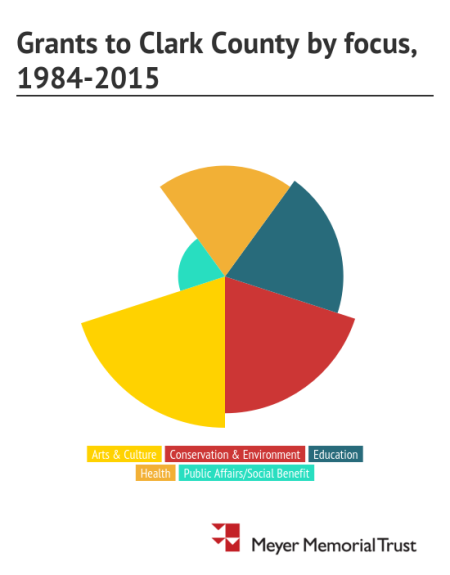Things change. Regardless of profession or industry, we all understand the need to grow and adapt in order to accomplish organizational goals. Yes, even before it was stated in the 1600s, change has been the only constant in life.
Over the last thirty years, there have been times that southwest Washington has struggled with this concept, but more often we’ve embraced the tides of transformation. Doing so has carried us across the economic spectrum from a reliance on natural resources, through a manufacturing boom in the 1940s, and now onward into the knowledge and technology sectors. This transition played out gradually over time and, while more condensed, our local nonprofit sector has a similar story of growth.
Three decades ago there were fewer nonprofits in southwest Washington and the Community Foundation was just sprouting. Local funders were scarce, and the M. J. Murdock Charitable Trust and Meyer Memorial Trust—then in their formative years—were facing stacks upon stacks of grant proposals. Recognizing the overwhelming community need, MMT chose to focus its efforts geographically. Oregon became its benefactor and southwest Washington—described by the trustees as “essentially” part of Oregon—was fortunate enough to fall under that scope.
At the time, MMT represented over half of the foundation assets in Oregon and about 25% of those in the Northwest. Now, just in Oregon, a number of funders, like the Ford Family Foundation and the Oregon Community Foundation, have since balanced that scale. Washington philanthropy has seen its own growth as well, with grantmakers such as the Bill & Melinda Gates Foundation and the Community Foundation for Southwest Washington expanding their reach and impact.
All of these developments have built Clark County’s nonprofit sector into a thriving economic contributor, accounting for $2.7 billion in revenue in 2013 according to figures compiled by the Nonprofit Network of Southwest Washington. That’s many times larger than it was thirty years ago. As a result, our community is more secure and less dependent on any single philanthropic organization.
Change strengthens our sector
Fast forward to last week when MMT added one more twist to our regional philanthropic history by announcing a change in local funding. The news: its current grant cycle—closing on March 15, 2015—would be the last to distribute grants directly to nonprofit projects and programs serving southwest Washington. The news came as a surprise to nonprofits, donors and leaders in our community. But MMT, which has awarded an average of $250,000 annually to programs operating in Clark County over the last three decades, isn’t leaving local groups in the lurch.
As MMT stops accepting grant applications from Clark County organizations, it will also make one final, lasting gift here with a $1.5 million grant to the Community Foundation for Southwest Washington. Of that gift, our grant committee will distribute $250,000 per year, during each of the next two years. In keeping with MMT’s long-term philosophy, these initial grants will target “capacity building” efforts. This includes everything from developing staff and leadership to growing programs, as long as it allows organizations to serve more people or become more effective.
The second portion of this grant ensures that MMT’s 30-year tradition of local giving continues to have a lasting influence on our community. In honor of Fred G. Meyer, the remaining $1 million will become endowed at the Community Foundation, providing community grants that will begin in 2017 and continue in perpetuity.
Meanwhile, MMT will stay true to its mission of supporting a flourishing and equitable Oregon. The leadership and staff of Meyer Memorial Trust are simply focusing their efforts to reflect changes in the funding environment. They have identified four key areas where they want to make significant impacts for Oregonians and are embracing their role as a state leader by helping to develop policy and direction around these issues.
Even as their decision means fewer dollars for our community, I applaud their efforts as a leader and nonprofit professional. The investments lost in Clark County will be offset by the increased impact MMT will create in Oregon as a result of this bold move, not to mention the ripples of influence its efforts will have across the Northwest.
A fond farewell
To be successful and make measurable change, every organization must regularly assess its operations. We all have to ask hard questions about how we can be most effective, and sometimes that means taking a difficult path. When funders are actively engaging in this process I feel very comfortable, because when grantmakers stop changing they often lose touch with the organizations they’re supposed to support.
So, while there may be some gut reactions at the moment, we need to remember the investments that MMT has bestowed on our community. Recognizing this is the right thing to do as we say farewell to a longtime supporter. After all, they are a large part of where we are today.
Sure, it’s hard to part, but this final gift is an amazing testament that our community knows where it’s headed and that we are prepared to make tough decisions of our own. Thankfully, today there are also more players that can pick up where MMT is leaving off. We’re proud to be partnering with them to do just that.
In the end, change itself isn’t that hard. We have been doing it for years. It’s only difficult in the moment. Our staff understands this, and we’re here to talk through any issues or concerns you might have. No matter where you stand, we’re always ready to help you or your organization navigate the funding landscape.
